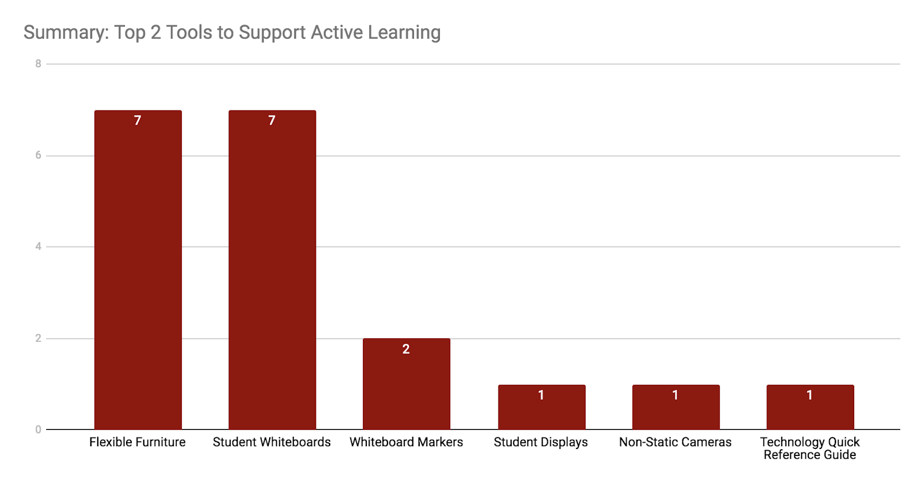Mosaic Senior Faculty Fellow Feedback
Findings: Tools to support active learning
Prompt 1: Which two tools would you pick to put in multiple classrooms to support active learning? Why?

SELECT DETAILED RESPONSES
Flexible furniture
- I would select furniture first, because without the ability to move freely within a classroom or to form functional student groups, the other tools are of little use.
- I think that furniture such as the Steelcase Node line, which makes moving around fast and easy, . . . allows for easy and quick room reconfigurations.
- Comfortable chairs with wheels . . . like the chairs in LC 1618 [which are] so easy for the students to learn in because they are not distracted by discomfort and they lose no time in forming small groups by wheeling away from the table and reconfiguring into sharing circles. But then you’d need tables that supported such chairs.
Student Group monitors
- I would select the table computer/monitors second. Students seem more engaged with the small table screens than with just the large room screen.
Technology Quick Reference Guide
- A quick reference info guide at workstations to help students independently navigate technology and a quick reference guide for faculty as to a vision of what resources can be used and a contact to someone for troubleshooting. It could even be a QR format that can easily be linked to our IUPUI website for updates and other resources.
Whiteboards
- As we continually work in groups and use Design Thinking approaches (Brainstorming, Journey Mapping, Prototyping, etc.) the ability to form various groupings of students and to display work visually is essential. By displaying work on whiteboards, students benefit from learning from others and develop the capability to express the meaning of their visual representations.
- I think that group-based whiteboards and markers would be one tool to promote collaborative and consensus building learning.
- Large standing whiteboards with telescoping legs – These can be used as standalone whiteboards that can be moved or positioned in different parts of the classroom, including on tabletops if the legs are shortened. These large whiteboards allow for maximum flexibility in terms of assignments, small groups, and room configuration in a way that personal whiteboards or large fixed ones do not. While I love the aesthetics of glassboards, I am now an advocate for the whiteboards that are depicted in the images.
Non-static camera
- Some sort of camera, similar to a GoPro, that is not static to enhance the broadcasting of motor activities [that are] similar to how a document camera can be used, but higher definition, so that skills can be demonstrated and either recorded for feedback, learning or used in distance education.

